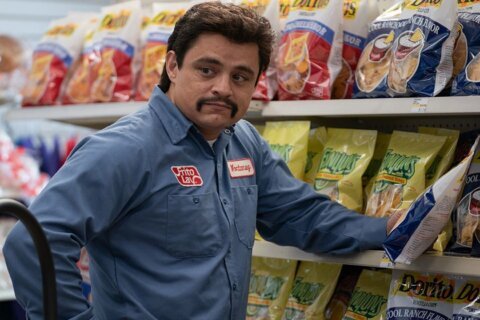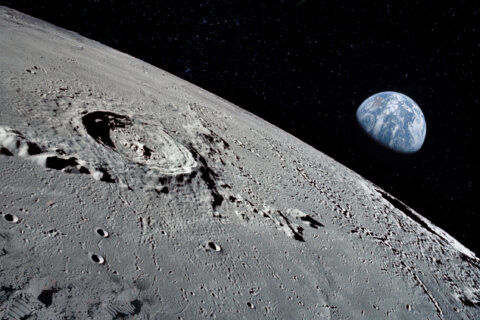Jason Fraley, WTOP Film Critic
WASHINGTON – “You think you know the story,” the tagline says.
But “The Cabin in the Woods” unfolds in most unexpected ways, mining pleasant surprises from genre archetypes as old as the hills have eyes.
The plot sounds similar to “The Evil Dead” (1981) — five friends take a trip to a remote cabin in the woods, but stumble upon an ancient book that unleashes a horrific evil. The characters are familiar — The Whore (Anna Hutchison), The Athlete (Chris Hemsworth), The Scholar (Jesse Williams), The Fool (Fran Kranz) and The Virgin (Kristen Connolly). We’ve even seen the set pieces before, like the lake pier that recalls “Friday the 13th” (1980).
But there are two additional characters, Sitterson (Richard Jenkins) and Hadley (Bradley Whitford), who throw us for a loop, riding around a high-tech complex in the film’s opening scene. Who are they? And what is their goal? The answers reveal a post-modern commentary on the horror genre, our desire for voyeurism, and a vague stab at explaining why horror exists in the first place.
The script was written by Joss Whedon, creator of TV’s “Buffy the Vampire Slayer” (1997) and “Angel” (1999), and Drew Goddard (“Cloverfield”), who wrote for both shows. The latter went on to co-produce “Lost” (2004) and “Alias” (2005), both of which you can see here in his directorial debut. Goddard molds Connolly into a tough heroine that would have made “Alias” proud, and we can see the same creative gears turning in his head that “moved the island” in “Lost.” Combine that with Whedon’s “Dollhouse” (1999), about a futuristic laboratory assigning tasks to its residents, and “Cabin” takes on themes that would make a fine double-feature with “The Hunger Games” (2012).
I won’t spoil the rest, for as Leonard Maltin wrote of “Vertigo” (1958), “To reveal more would be unthinkable.” Just go in anticipating a dark comedy capable of the line, “Good work, zombie arm.” “Cabin” features some true laugh-out-loud lines, taking the black comedy pioneered by Hitchcock, running it through the “over the top” ringer of Raimi, and converting it into the self-analysis of Craven. While Craven’s “Scream” (1996) taught us to never say “I’ll be right back,” “Cabin” dares us to read ancient Latin text, have sex in the woods and split up the group just when the going gets tough.
Whedon and Goddard keep a watchful eye over the entire experiment, just like the two-way mirror that allows the characters to gaze from one room into another (Norman Bates eat your heart out). They’re the master controllers of “Das Experiment” (2001), running a test of various genre elements and watching the results through the “safety” of their camera lenses.
“It’s basically a very loving hate letter,” Whedon told Total Film.com. “… It’s a serious critique of what we love and what we don’t about horror movies. … I love being scared. I love that mixture of thrill, of horror, that objectification/identification thing of wanting definitely for the people to be alright but at the same time hoping they’ll go somewhere dark and face something awful.”
This love is reflected in a series of loving homages, from a gas station attendant reminiscent of “The Texas Chain Saw Massacre” (1974) to Japanese children hailing their J-Horror defeat of the dark-haired girl from “Ringu” (1998), a.k.a. “The Ring” (2002).
“The things that I don’t like are kids acting like idiots, the devolution of the horror movie into torture porn and into a long series of sadistic comeuppances,” Whedon said. “Drew and I both felt that the pendulum had swung a little too far in that direction.”
This hate is why “Cabin” took years to hit theaters. It was actually shot in 2009, a year before the “torture porn” height of “Saw 3D” (2010). However, the release was postponed because the studio wanted to covert it to 3D. When Whedon and Goddard revolted, the idea was scrapped, allowing the film to premiere at South by Southwest last month in its original 2D.
That’s not to say the film lacks gore. On the contrary, its resilient monsters — from zombies to clowns to unicorns — unleash a dazzling tableau of carnage to satisfy even the most blood-thirsty of viewers. Still, these creatures are oddly sympathetic and overseen by one of the genre’s true matriarchs (cameo alert). As she explains the root of our “horror” obsessions, we recall a previous exchange with the film’s moral compass, a man aptly named “Truman.”
TRUMAN: “Monsters? Magic? Gods?”
LIN: “You just get used to it.”
TRUMAN: “Should you?”
If you aren’t a fan of the genre, you should obviously stay away. If you’re a fan of typical horror, you may find the film far too strange — and thus become the butt of its joke. But if you like movies that break down their own genres, expose their flaws and celebrate their quirks, this one’s for you.
I didn’t walk out of the theater blown away, and I don’t see it becoming an iconic movie like “Jaws” (1975), “The Shining” (1980) or “The Exorcist” (1973). But I did find it a fascinating experiment. I have a feeling Whedon and Goddard would be thrilled if we simply leave the theater contemplating genre elements we took for granted when we first sat down. We should reward these “out of the box” thinkers and urge them to keep creating.
★ ★ ★
The above rating is based on a 4-star system. Read more from WTOP Film Critic Jason Fraley by clicking “Fraley on Film” under the “Living” tab above, and check out his blog, The Film Spectrum.
(Copyright 2012 by WTOP. All Rights Reserved.)








